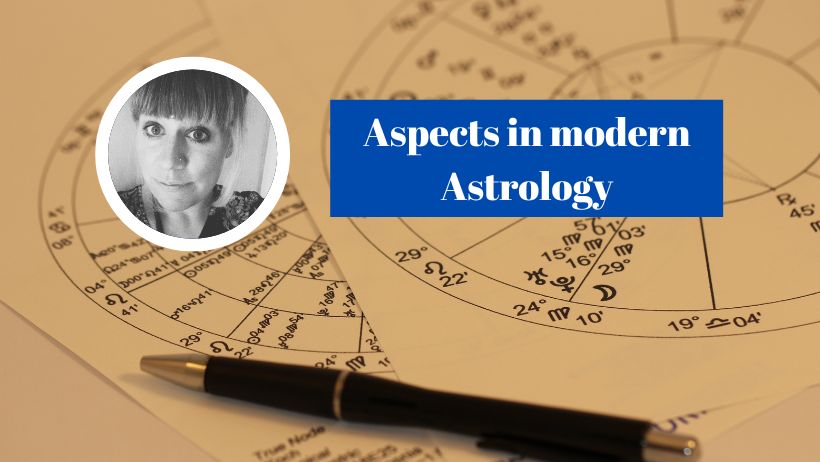Aspects are an essential part of modern astrology. As the planets move in their elongated orbits around the Sun, they form various angular relationships with one another, using the Sun (or Earth) as the center. These are called Aspects. Dependent on your birth chart, those aspects will have a particular influence or effect that can be felt and seen in certain areas of your life. Some aspects, mainly caused by transits, can change our personality or outlook on life.
The most popular aspects
We can find out about the most popular aspects in modern astrology in your birth chart by dividing the circle by numbers like 1,2,3,4. This results in aspects such as the conjunction (0 degrees), opposition (180 degrees), trine (120 degrees), square (90 degrees), and so forth. There are more favorable aspects and there are some challenging aspects.
We all have certain aspects in our natal chart which determine a certain basic energetic constitution. Areas in which we experience challenges inside us, that we have to overcome. At the same time, it can show places on the outside in which we might experience blockages and opposition that we have to overcome. The same is with beneficial soft aspects which show us which areas we tend to flow more smoothly.
Aspects that form or get activated over time - TRANSITS
A transit occurs when a planet stops at a degree conjunct, trine, sextile, or in opposition to a natal planet in your chart. Some aspects not set in our natal chart will be formed, but they come along by us living our lives. While the Earth and other planets have a specific path that circulates the sun, they can form aspects of our natal chart and activate certain areas. Transit is an external force, whereas natal planets are internal.
A Saturn transit to Venus would indicate that external circumstances could cause you to build stability about the things you find valuable. These are times when particular problems arise or obstacles are lifted out of our way, and we might change our outlook on things. It depends on which aspects get formed and what kind of energies get triggered. I work closely with the meaning and impact of timely aspects when I conduct my 12-month Astrology Forecast Readings.

When two planets form an aspect with one another, their energies and natures are said to combine and work in harmony or discord. For example, when two planets are exactly on opposite sides of the Sun (earth), they are in opposition which marks challenging aspects.
The most popular aspects can be divided into three main categories:
Emphatic aspects in astrology:
The emphatic aspects in astrology emphasize or align two planetary energies with one another—conjunction (0 degrees). When two planets at the same point in the zodiac are said to be in conjunctions, their natures are fused or blended into one, which with some planets can be harmonious while others might challenge each other.
Opposition (180 degrees) Two planets at opposite sides of the zodiac. The energies are in alignment with each other. They can pull together or apart, depending upon the nature of the planets involved and if we have the understanding and the tools to work with this.
Hard aspects in astrology:
Square (90 degrees) and semi-square (45 degrees). These represent challenges, obstacles, and substance. They provide the substance of our life. Square aspects challenge us to become stronger or find another solution to a problem. They can also indicate issues we must overcome on the inside or outside to move forward. Too many can block or obstruct the life flow, yet too few can cause life to be weak or thin and not allow us to grow stronger.
Soft aspects in astrology:
Trine (120 degrees) and Sextile (60 degrees). The soft aspects bring ease, clarity, and vision to our lives. We can see, grasp, and understand what is happening. This can also be a time when obstacles suddenly lift or disappear. Things work out in our favor, and we receive the help we need.
Too few soft aspects mean we don’t know what we are doing or what is happening in our lives, while too many soft aspects make for a life that runs cool, is overly mental, and lacks substance.
Exact aspects have the most significant impact.
The range within which an aspect in astrology operates is called its ‘orb of influence’ or simply its orb. An orb of one or two degrees of arc on either side of the exact aspect is considered a close or tight orb, while an orb of 10 degrees is loose. Yet, the effect of most aspects can be felt for some time before and after the moment when it is exact.
Which planets are involved?
Also worthy of consideration when looking at aspects are the planets involved. Aspects of the Sun and Moon are most important, followed by the planetary aspects involving Mercury, Venus, and Mars because they are the personal planets, meaning their impact is very tangible on the inside individual level.
While aspects formed by Jupiter or Saturn can still be significant and indicate restriction or growth and expansion, this can be abrupt, dissolving, or confusing, as well as a massive transformation. The transpersonal planets or generational planets such as Uranus, Neptune, and Pluto will more than likely have a wider aspect influence.
Check your birth chart
If your natal chart has an accurate birth time, aspects of the chart angles (ascendant and midheaven) are also important. Aspects in astrology between planets such as Saturn and Mars are more potentially explosive than the same aspect between Venus and Jupiter because the planets have their energetic makeup that interacts with each other. The particular combination can make a difference.
As you can see, reading a horoscope is not that easy, and each birth chart has many facets and layers. When working with Karmic Astrology another aspect becomes rather important. The Karmic Axis and its meaning will allow us to understand your chosen life path and its lessons in this lifetime. Furthermore, in this Reading, I will analyze your karmic aspects and what they mean for you. This is a powerful way to bridge the influence of the past and connect it with the present and future potential.





